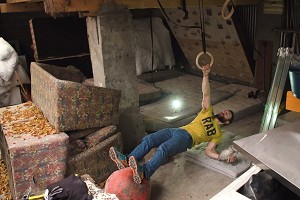
This article provides a basic guide to some do's and don'ts on the subject, taking into account previous discussions on the forums.
The article assumes that the climber is about to embark on a traditional Scottish climbing trip(s) rather than some more exotic and elevated destination. Some have suggested that for a typical Scottish winter having blunt tips is not a problem. The case seems to be based on two things:
- You will be walking and climbing with kit and bashing the things into rocks all the time so tools will inevitably be blunted quite quickly. Clearly this is more true of mixed stuff than snow/ice.
- Scottish neve, which is what most of us hope to climb on in winter, is far more plastic than water ice and therefore sharp points are less of a concern as the medium is more forgiving.
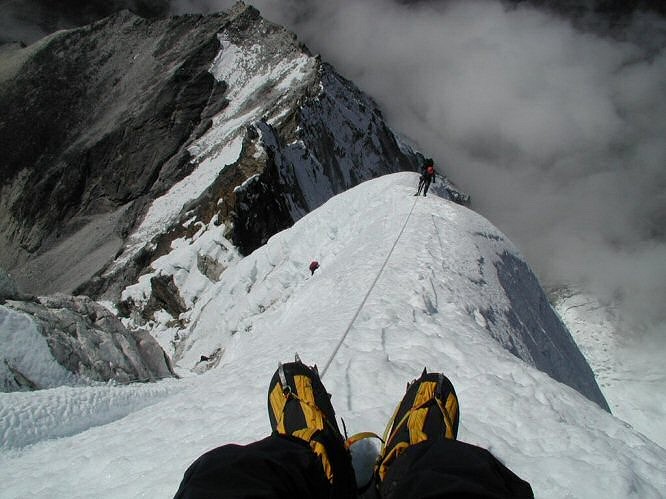
They seem valid opinions but most would consider starting with sharp tools is no bad thing and some venues (such as Beinn Udlaidh) are actually water ice and need decent points. Given that there is not much effort involved and it allows you to check your tools before bowling up at the bottom of Orion Face in March I am of the view it is no bad thing to sharpen things up. Of course the more sharpening you do the more metal you remove and eventually you will run out, so don't over do things.
Tools for the job
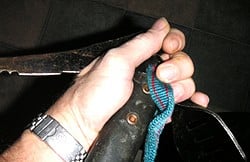
At this point we should perhaps mention power tools and grinders. Put simply don't use these for two reasons:
- They can generate very significant heat in the work piece and this can have an adverse effect on the tools heat treatment and therefore mechanical properties. The result could well be a tool with very poor strength and ductility.
- These are violent tools and if used on thin things like axes and crampons there is a risk that too much metal will be removed rendering the tool useless.
Using a hand file some heat will be generated in the tool being worked. This is not going to be sufficient to cause problems for the heat treatment or mechanical properties of the tool so don't worry about it.
Technique
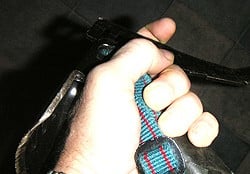
If you do use a vice then arrange the axe tip so that it points down, you have access to both sides of the tip and it is set in the vice so that the axe is clamped just under the head. Crampons are altogether trickier given the shape and points so you will have to work out what is best for you, avoid clamping across the crampons main axis as this could cause it to bend. You could try using wood blocks between the vice and crampon, the points will push into the wood but shouldn't damaged. Again arrange it so that you can file down and away from you and with crampons expect to have to turn them to do both points.
If not using a vice then there are two options:
- Hold the axe blade tip over the edge of a flat surface and press firmly down on the top of the shaft with one hand so that you can use the file with the other hand. Again crampons are trickier for the obvious reasons, although pressing the points into a cork tile on a piece of wood works.
- You can do the work with the axe/crampon by simply holding it firmly in one hand, see photos.
File slowly using deliberate strokes and with a uniform pressure applied, using the middle of the blade to do the work, you have better control that way compared to the far end of the file. Follow the profile of the original tip as best you can, clearly this is going to be more difficult on older tools than newer ones. File only in one direction, the teeth on the file only go one way so rapidly rubbing the file backwards and forwards is not going to get the job done, it blunts the file, roughens the surface of what you are working on and you get tired very quickly. Also going from say, top to bottom and then reversing it to bottom to top is likely to undo the work you have already done. I have seen some guidance that says one should file in the direction of the metal grain, ignore this, there is no real way of knowing the “grain” unless you look under a microscope and there is a fair chance it has no direction anyway.
You should aim to apply the same number of strokes to each side of the tool tip by alternating the strokes left and right, there is no need to get all anal about this. Equally there is no point in doing 100 strokes on the left and 1 on the right; what you are aiming for is a balanced edge on the tip. Every few strokes run a finger along each side to see how things are going and to make sure it is all balanced (be careful with this as there made be shards of metal sticking out of the surface and these hurt if they poke into your digit).
How sharp is sharp?
There is no definitive answer to this; personal preference and what you intend climbing influence the final sharpness. One crampon manufacturer suggests that you should be able to press the point with a thumb and it not hurt, suppose it depends on your pain threshold. What you don't want to do is sharpen the things to a fine needle like point, useless, takes a lot of effort and is easily blunted. What you want is an edge to each tip that meets at a chisel point or a V depending on the original profile for example conventional style will have a horizontal V while more modern designs have a vertical chisel. You will know when the thing has changed because you can compare to the tip you have yet to work on.
What should I sharpen?
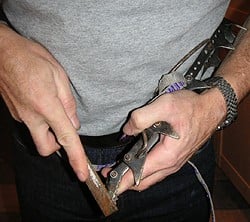
Some climbers will also use filing techniques to re-profile axe blades and perhaps even modify and remove teeth in the blade. If you are doing that then you don't need this basic article but the principles remain the same. However, be aware once you have removed the metal and reshaped a blade you can't change it back!
Final Thoughts. As you have the tool box out and are giving your long forgotten winter gear some attention this a good time to check all the nuts & bolts are tight, there are no cracks, binding are in good condition, nothing is hanging off that shouldn't and it all still fits together as it should.
One final word of caution, if you are going to do the sharpening in your mums/other halves front room while watching the telly then put an old newspaper or some such on the floor. Failure to do so will result in grief for the next 6 months as they pick iron fillings out of the shag pile.
With thanks to “blurry” who asked the question in the gear forum during preparation of the article and was good enough to proof read and check the usefulness of it in order to get the answer to his question, cheers.
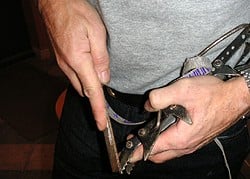
You can read an interview with Graham here.




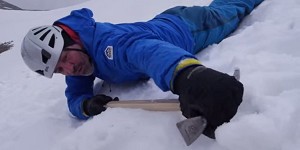











Comments